U.S. Department of Transportation
Federal Highway Administration
1200 New Jersey Avenue, SE
Washington, DC 20590
202-366-4000
Federal Highway Administration Research and Technology
Coordinating, Developing, and Delivering Highway Transportation Innovations
| REPORT |
| This report is an archived publication and may contain dated technical, contact, and link information |
|
| Publication Number: FHWA-HRT-15-049 Date: April 2015 |
Publication Number: FHWA-HRT-15-049 Date: April 2015 |
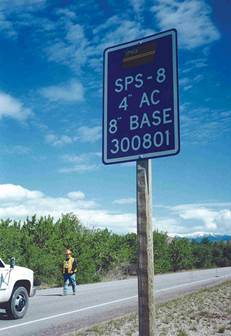 |
| The shaping of the LTPP experiments was a lengthy process that was already underway before the program officially began and has extended through both the SHRP and FHWA management periods. |
At the heart of the LTPP program were the pavement experiments. The design of the experiments was an integral part of the planning and preparation for the program, and ultimately critical to its success. Highway agency, industry, and university representatives collaborated to design experiments located across various climates that would use different materials and carry different traffic loads to assist in understanding how and why pavements perform as they do.
The shaping of the LTPP experiments was a lengthy process that was already underway before the program officially began and has extended through both the Strategic Highway Research Program (SHRP) and Federal Highway Administration (FHWA) management periods. In the early 1980s, FHWA had been working on design plans to field test different pavements and materials to evaluate their performance over time.
Experts in the pavement engineering and statistics areas, including those on the Expert Task Group (ETG) on Experimental Design and Analysis (appendix A), helped to formulate the LTPP experiments. The ETG worked with the Pavement Performance Advisory Committee to identify the types of experiments they envisioned would accomplish the different objectives for the pavement performance monitoring program.1,2,3 In the mid-1980s when planning began, three study types were considered: General Pavement Studies (GPS), Specific Pavement Studies (SPS), and Accelerated Pavement Testing.
The GPS experiments sought to use in-service pavement sections to examine general performance by pavement type. It was thought that these sections would provide relatively quick and cost-efficient insights into the performance of pavement designs generally used in the United States and Canada at the time. In contrast, the SPS studies were designed to investigate the influence on performance of specific features, such as drainage, layer thickness, and rehabilitation or maintenance treatments. These sections were to be constructed specifically for the LTPP study. In the third type of study proposed, Accelerated Pavement Testing, sections would be constructed and loaded using a machine simulating traffic for rapid study results. After consideration and deliberation, it was ultimately decided to proceed with the GPS and SPS experiments as part of the SHRP-LTPP program and to pursue accelerated pavement testing under separate efforts. As highway agencies adopt new pavement technologies, new experiments are designed to evaluate the long-term performance of these technologies.
The remaining sections in this chapter briefly discuss the original experiment designs and recruitment of the test sections, as well as the roles that SHRP, FHWA, and the program’s contractors had in implementing the LTPP experiments. The general design criteria and design issues specific to the GPS and SPS experiments are discussed in the sidebar. A more thorough discussion of the evolution of the LTPP experiments is found in SHRP-LTPP Overview: Five-Year Report.4
| Key Milestones in the Design of the Experiments | |
|---|---|
| 1985 | First meeting of the Pavement Performance Advisory Committee to discuss LTPP objectives, experiment designs, and management of the program |
| 1988 | Selection of first GPS test site |
| 1988 | First FWD and materials data collection, in North Carolina |
| 1989 | Selection of SPS test sites begins |
| 1990 | Construction of first SPS project |
| 1990 | First SPS maintenance and rehabilitation sections selected |
| 1992 | First pilot for SPS-9, in Arizona |
| 2000 | Construction of last SPS project under original LTPP experiments |
| 2012 | Planning for warm-mix asphalt experiment begins, first new LTPP experiment in 20 years |
| 2014 | Recruitment begins for new warm-mix asphalt experiment (SPS-10) |
| 2014 | Planning for pavement preservation experiment begins |
As mentioned previously, the purpose for monitoring GPS test sections was to observe the performance of in-service pavement sections to the end of their design lives. This approach had both advantages and disadvantages. It allowed for relatively rapid implementation, as no construction was required, and it provided data to begin populating the LTPP database. On the other hand, the structural condition of the pavement when it was first built, or its condition prior to overlay for some experiments, was sometimes unknown, making it extremely difficult to consider this important information in analysis of the data.
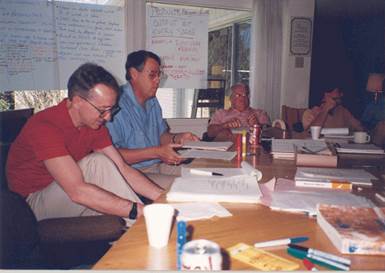 Early program planners meet to discuss the experiment designs and vision for the LTPP program (left to right, Ralph Haas, John German, Virgil Anderson, and Ed Pensok). |
GENERAL DESIGN CRITERIAIn formulating the design criteria for the GPS and SPS experiments, certain criteria were common for both experiments. For example, all GPS and SPS test sections are in the outside single lane (“slow lane”) of the roadways. In addition, the original test section length was planned to be 1,500 ft (457.2 m), but at the SHRP-LTPP Advisory Committee meeting in February 1988, it was agreed to shorten the section length to 500 ft (152.4 m). Reasons for this change included the difficulty in finding homogeneous sections 1,500 ft in length and the acknowledgment that performance should be sufficiently consistent over a 500-ft length to account for general roadway conditions. In addition, 500 ft was the shortest length permitting measurement of 250-ft (76.2-m) longitudinal profile wavelengths.5 In practice there are some exceptions: some SPS-6 sections (rehabilitation of jointed Portland cement concrete) are 1,000 ft (304.8 m) long, and some “supplementals” are shorter or longer than the prescribed 500 ft. “Supplementals” are test sections added to SPS sites by the States and Provinces to examine features of particular interest to them.
|
Nine pavement types or studies were originally planned for the GPS experiments. Preliminary work in these studies focused on finding pavement test sections meeting the defined criteria for each of the studies. Experimental matrices were developed to help encourage a distribution of primary experimental factors, such as layer thickness, traffic level, and subgrade type (figure 5.1).
It became clear from early efforts that many of the factorial combinations did not exist. Certain pavement types had not been built in some parts of the country, and highway agencies did not build relatively thin roadways for relatively heavy traffic. As a result of the initial section recruitment efforts, modifications to the GPS experiment plans were considered. After review, pavement experts and statisticians recommended changes to seven of the nine original experiments.
Following review and discussion by the Advisory Committee with expert input from pavement engineers and statisticians, several changes were made to the GPS experiments. Table 5.1 outlines the basic experiments as originally called for, the changes recommended, and the decision to implement the changes by SHRP. Each experiment had sub-experiments not shown in table 5.1. For example, the variations in the design of asphalt concrete (AC) thickness, AC stiffness, and base and subbase characteristics were examined in the GPS-1 test sections (as shown in figure 5.1). Details of the design process and the final GPS designs are available in the SHRP 5-year and midcourse assessment meeting reports. 7,8,9
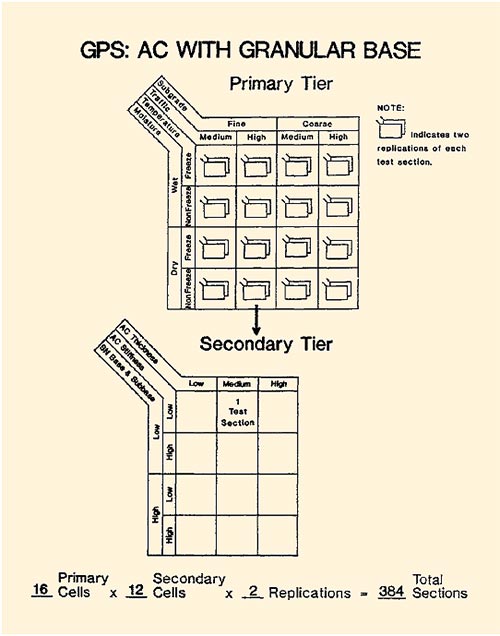 FIGURE 5.1. Example of the research matrices used to plan the GPS experiments (AC = asphalt concrete, SN = structural number).6 |
At subsequent meetings of the LTPP Advisory Committee, two other significant changes were made:
Later in the program, the GPS-6 and -7 overlay experiments were further divided as a result of the Program Assessment undertaken in 1996 (chapter 11). This assessment determined that the program lacked rehabilitation test sections and that this area of the program needed improvement. To remedy this deficit, it was decided that once a highway agency rehabilitated a test section to address safety or deterioration issues, the LTPP program would move the test section to one of the following GPS-6 or -7 sub-experiments, with the concurrence and continued support of the highway agency:
| Original GPS Experiments | Changes Recommended | Were Changes Implemented? |
|---|---|---|
| Asphalt Concrete (AC) Over Granular Base |
|
No. Final experiment name:
|
| AC Over Stabilized Base |
|
Yes.
In addition, the experiment was further modified to allow delineation of
asphalt-treated base and cement-treated base. Final experiment name:
|
| Jointed Plain Concrete (JPC) |
|
No.
JPC placed directly on treated or
untreated subgrade was not permitted in
the experiment. Final experiment name:
|
| Jointed Reinforced Concrete (JRC) |
|
No.
Final experiment name:
|
| Continuously Reinforced Concrete (CRC) |
|
Yes. Final experiment name:
|
| AC Overlay of AC |
|
Yes.
The experiment was divided into existing and planned overlays, and AC
stiffness was deleted as a factor. Final experiment name:
|
| AC Overlay of Jointed Portland Cement Concrete (PCC) |
|
Yes.
However, the dry environmental zones
were not combined, but JRC pavement was eliminated. The experiment was
divided into existing and planned overlays, and AC stiffness was deleted as a
factor. Final experiment name:
|
| Bonded Jointed Concrete Pavement (JCP) Overlay of JCP and CRC Pavements |
|
Yes. The SPS-7 (bonded PCC overlay of PCC pavements) experiment was later formulated to address this rehabilitation alternative. |
| Unbonded JCP Overlay of JCP and CRC Pavements |
|
Yes.
Final experiment name:
|
In the recruitment of GPS test sections, participating highway agencies were advised of the section needs and asked to review their records for pavements meeting the study criteria. Agency personnel reviewed many potential roadways to find sections that met the needs of the program and submitted them to their respective LTPP regional coordination office contractor (later called “regional support contractor”) for consideration. The LTPP regional coordination office contractors were firms with expertise in pavement monitoring and testing. Under SHRP management of the LTPP program, a SHRP regional engineer was also assigned to each regional office. The SHRP regional engineer and the regional coordination office contractor staff sorted the candidate sections into the experimental matrices to ensure that the variation in experimental factors desired was actually achieved. SHRP program staff, assisted by the technical assistance contractor (later called “technical support services contractor”), reviewed the potential candidates and provided recommendations for acceptance or rejection of a candidate section. Once this was done and sections meeting the stated criteria were identified, the highway agencies were advised of the selections. Wherever there were multiple projects meeting needs of the same cell, the test sections were sorted and information was maintained for substitution if needed.
After the highway agencies identified the sections, the regional coordination office contractors made field trips to confirm section characteristics and to find and mark out 500-ft (152.4-m) sections for study (figure 5.2). These field trips were an eye-opening experience, as in many cases it was found that the actual section characteristics were vastly different from what was expected. In some cases, layer types and thicknesses varied, and in others the cut/fill transitions or traffic generators (on/off ramps or intersections) prevented the identification of suitable sections for study. During these field visits, cores were obtained at the ends of each section, to confirm layer types and thicknesses. Wherever possible, a section location was found, documented, marked out, and confirmed for study.
Once the field visits were completed, the sections were re-sorted in the experiment matrices based on actual field conditions. This process resulted in many sections changing experiment cells. To fill in the cell gaps, additional sections were recruited and selected. In this iterative process, the GPS experiments were populated with test sections for study. Figure 5.3 shows an example of a GPS sampling template used to populate the LTPP experiments.
In the end, many cells were devoid of sections. Many of these empty cells had extreme criteria, for example, thin sections with high traffic and fine subgrade. These sections simply had not been built, since the highway agencies knew that they would fail in a short time. It was also found that certain pavement types did not exist in certain parts of the country, making the combination of pavement type and environmental zone difficult to achieve in some places. Consequently, some GPS experimental cells were destined to remain empty. Some of these needs could be addressed through the SPS experiments, where sections would be constructed, but in other cases, there was no practical way to address the gap.
Later in the program, as the pavement performance of some of the test sections began to decline and highway agencies needed to restore performance through rehabilitation activities, many of the pavements in the flexible (GPS-1 and -2) and rigid (GPS-3, -4, and -5) experiments moved to the GPS-6 (AC overlay of AC pavement) and GPS-7 (AC overlay of PCC on concrete pavements) experiments after rehabilitation. Continued monitoring of these sections provided ample data before and after rehabilitation.
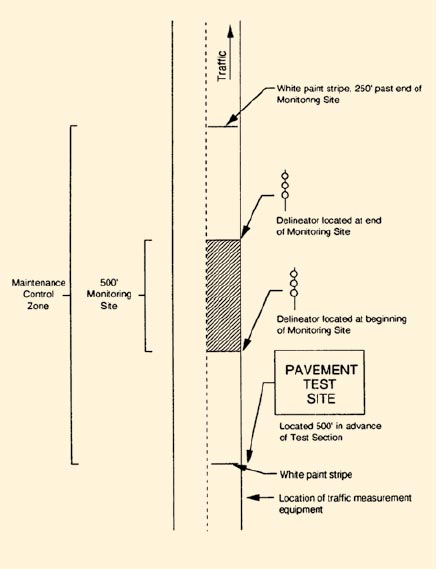 Figure 5.2. Designated layout for GPS test sites.11 |
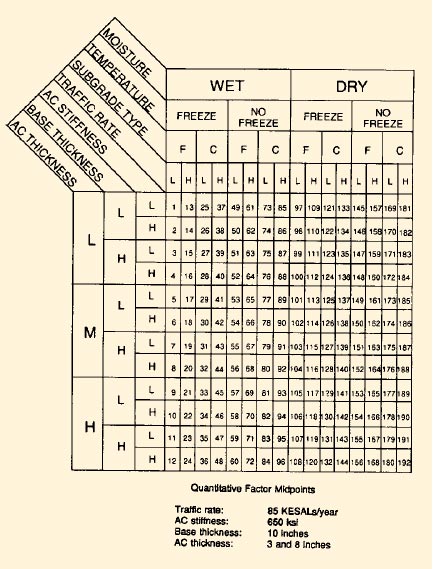 Figure 5.3. Sampling template and cell identification numbers for GPS-1 (asphalt concrete on granular base).12 |
The GPS experiments were to be augmented by research into the impact of specific design features in the SPS experiments. The two study types share a symbiotic relationship, in that the findings from each complement the other. The primary difference in the two is that the SPS experiments generally involve some type of construction and tighter control of experimental parameters. Construction focused on providing specific design features for study, such as drainage features, layer thicknesses, base types, or treatment prior to rehabilitation. It was recognized that in some cases SPS results would take longer to realize, but the insights offered would be worth the wait.
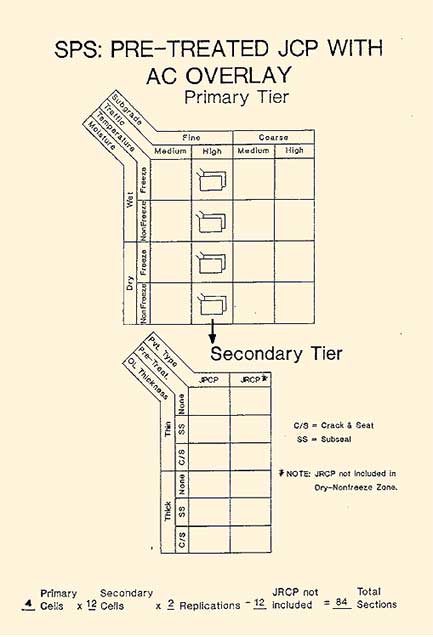 Figure 5.4. Example of the research design matrices created for the Specific Pavement Study experiments (JCP = jointed concrete pavement; AC = asphalt concrete; JRCP = jointed reinforced concrete pavement).15 |
Efforts began with a “shopping list” of potential studies, gathered over a period of time. In the original plans for the SPS experiment designs, 18 general topics were selected for intensive experiments for flexible and rigid pavements, and design matrices were formulated for many of them in the Strategic Highway Research Program Research Plans (“Brown Book”) (see example in figure 5.4).13
The SHRP technical assistance contractor developed preliminary designs based on the matrices and details presented in the Brown Book. The preliminary designs were reviewed by a working group that included representatives from highway agencies, FHWA, SHRP, and the contractors. Drawing on the observations of the working group, the SHRP contractors then prepared a draft design, and the draft was presented in study workshops for review by representatives of State and Provincial highway agencies, the pavement industry, and FHWA. As many as 26 highway agencies were represented in the study workshops, and the recommendations from the workshop reviews were incorporated in the final experimental designs.14
In 1987, an effort was undertaken to reduce the number of original SPS design plans and to define the methods required to analyze the data from each. At that time a decision was made to divide the SPS into five major categories: Structural Factors, Preventative Maintenance, Pavement Rehabilitation, Environmental Factors, and Load Equivalencies. These major categories were further subdivided into specific experiments (table 5.2).
During 1989 and 1990, a number of analytical studies were undertaken to further define the SPS experiment designs. In particular, Strategic Pavement Design Initiatives for SPS-1 (structural factors for flexible pavements) and SPS-2 (structural factors for rigid pavements) were considered, and the value of sub-experiments to explore and isolate the relative effects of different factors and combinations of factors was investigated. These investigations led to the development of experiment designs and research plans for SPS-1 and SPS-2. During the same time, guidelines were developed for nomination and evaluation of candidate projects for SPS-5 (rehabilitation for asphalt concrete pavements), SPS-6 (rehabilitation of jointed concrete pavements), and SPS-7 (bonded PCC overlays). Ultimately, a suite of guidelines was developed—for nomination and evaluation, data collection, material sampling and testing, and construction—for each of the SPS experiments.
| Original SPS Experiments | Changes Recommended | Were Changes Implemented? |
|---|---|---|
|
Structural Factors
|
Yes. Resulted in two experiments:
|
|
Preventive Maintenance
|
No.
Preventive maintenance studies were given specific names:
|
|
Pavement Rehabilitation
|
Yes.
Resulted in three experiments:
|
|
Environmental
Factors
|
Yes. Resulted in one experiment:
|
|
Load
Equivalencies
|
No. At the time, separating traffic to study true load equivalencies was impractical, so the experiment was not considered beyond the conceptual phase in spite of the perceived relative importance of the result. |
AGENCIES' USE OF SUPPLEMENTAL SPS TEST SECTIONSMany highway agencies chose to construct supplemental sections on SPS projects. Recognizing the value of consistent long-term monitoring on these sections, a variety of approaches were taken in their design. For example, many agencies used their standard mix design and structural section on the pavement adjacent to the 12 core sections on an SPS-2 project to compare the performance of their standard practice with that of the core sections. The Arizona Department of Transportation took this strategy a step further and constructed nine supplemental sections that examined alternative joint configurations, structural sections, and even pavement types. The department is currently studying the performance, after 20 years, of the supplemental sections relative to each other and to the core sections—recognizing that all 21 sections are still in the study and there is more to be learned going forward. Typical variations between the core sections and supplemental sections involve changing material properties, structural thicknesses, and design properties (e.g., lane width). In another example of supplemental sections, several States in the western part of the country—Arizona, California, Colorado, Nevada, and Utah—collaborated on a study of joint sealants as part of the SPS-4 experiment. This study included more than 100 supplemental sections. As future SPS projects are constructed, the opportunity to include supplemental sections is an excellent incentive for participation on the part of highway agencies. |
Concurrent with the development of the LTPP GPS and SPS experiments, the asphalt research area under SHRP was developing the Superpave® mix design method. Once the method was developed and ready for field implementation, it was deemed prudent to study the performance of the new mix designs in the field in controlled experiments. In the 1990s, the SHRP Asphalt Research Group worked with the LTPP program to develop an SPS experiment (SPS-9: Validation of Strategic Highway Research Program Asphalt Specification and Mix Design (Superpave®)) for the long-term study of performance of the Superpave mixtures. This experiment design included placement of three test sections: a control section using the highway agency’s normal mix design, a section with a Superpave mix designed for the climate in question, and a section with a Superpave mix designed one grade lower than optimum. The Superpave projects were both new construction and rehabilitation projects that covered an array of asphalt aggregate mixture specifications and were recruited consistent with the methods used to find sites for the other SPS experiments.16 The data were collected as part of the LTPP program and stored in the database.
Unlike the GPS test sections, highway agencies were permitted to construct supplemental sections for all SPS projects, in addition to the core experimental sections to monitor factors specific to their agency. Two such examples are described in the sidebar. Data from these supplemental sections are collected as part of the LTPP program and included in the database.
Recruitment of sites for the SPS test sections was even more involved than for the GPS sections. For the SPS experiments, the test sections were to be constructed, meaning that suitable projects and a commitment from the highway agency to incorporate special provisions for construction into a planned project had to be obtained. The SPS sections also differed in that each SPS project incorporated several test sections at a location. Given the complexity of the studies and the importance of the results, intensive planning was required. Because of these requirements, and because agencies must work construction activities into their existing programs, some SPS projects were constructed as late as 2000.
Although the SPS experiments had been generally defined, construction details had not been finalized to the point that construction documents could be developed from them. A series of national meetings was held in the late 1980s to obtain input from all of the involved partners and to develop draft construction guideline documents for each of the high-priority SPS experiments: SPS-1, -2, -5, and -6. (The final guidelines are listed in table 9.1.) These particular experiments were considered high priority because they were new sites with specific design and construction criteria to meet a particular research need for the LTPP program. The other LTPP experiments were just as important to the overall goal of the program, and were equally important in meeting the program’s objectives. SHRP program staff and the LTPP technical assistance contractor gathered all of the input and worked this information into comprehensive construction guidelines that highway agencies could use to develop project plans. These documents also served as the basis for the project recruitment guidelines, since they essentially outlined project needs. The guidelines generally covered nomination and evaluation, data collection, materials sampling and testing, and construction. The guidelines also provided clear instruction for field activities and data forms for recording required information through the site evaluation and construction process. An example of an SPS test section layout for SPS-1 and -2 is shown in figure 5.5. It is important to note, however, that the number of test sections monitored for other SPS experiments may differ from what is shown.
The other SPS experiments that were new construction included SPS-8 (environmental factors in absence of heavy loads) and some SPS-9 sites. SPS-3 and -4 were maintenance studies of flexible and rigid pavements, respectively, and SPS-7 and some SPS-9s were overlays. All of these experiments followed a similar but less restrictive process of nomination and construction than the high-priority SPS experiments. On the high-priority sites, deviations from the design and construction guidelines were not permitted.
The project nomination and screening process was organized and methodical, designed to select the best candidates for study from the available construction projects. Test section locations were to be selected to minimize or avoid altogether transitions from cut to fill or unusual variations in distress along the project length. On ramps, off ramps, or other traffic generators were also to be avoided. With these and other considerations to be met, selection of projects became a challenging task. Still, in the end, recruitment and selection efforts resulted in a majority of the required experiment design needs being filled.
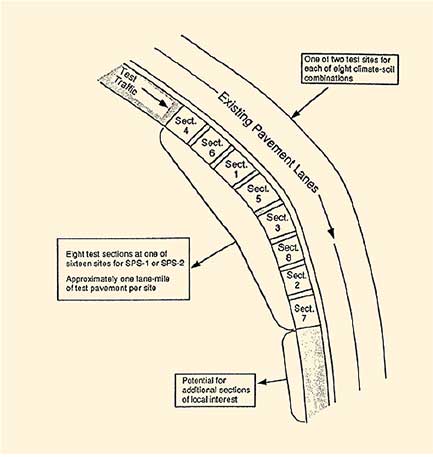 FIGURE 5.5. Test section layout for SPS-1 and SPS-2 projects (Strategic Studies of Structural Factors for Flexible and Rigid Pavements, respectively).17 |
In response to feedback from highway agencies regarding concerns about increased costs for items such as traffic control needed during field testing, collection of traffic data, and costs associated with more detailed materials testing, FHWA agreed to monetary incentives for agency participation in the construction of SPS projects. Agencies were provided $50,000 for each SPS-1 or SPS-2 project they constructed and $35,000 for each SPS-5 or SPS-6 project they constructed. The roles and responsibilities of the highway agencies had to be understood and agreed to, as part of the data collection requirement fell on their shoulders (mainly materials testing and monitored traffic data collection).
With all of these pieces in place, highway agencies started the process of identifying projects best suited to the construction for the SPS test sections. This process was a slow one, starting in about 1989 and ending in about 2000. Suitable projects were identified, construction plans developed and altered to include the test sections, and specifications developed for pay items not part of normal agency practice (e.g., permeable asphalt-treated base).
Construction coordination frequently involved participation of the LTPP regional coordination office contractor in a pre-construction meeting with the agency staff and its contractor to discuss the importance of the experimental test sections and adherence to the plans and specifications. Agreement also had to be reached on the function of the LTPP regional coordination office contractor staff on site, typically during the construction process, to monitor the progress and record key pieces of information during construction. In many ways this was a difficult process for highway agency construction contractors to understand, and success depended on their, as much as the agency’s, understanding and accepting the requirements.
The need for monitoring of the original SPS experiments continues into the future. In addition, the LTPP program is adding new SPS experiments to address 21st century pavement needs, such as warm-mix asphalt concrete (SPS-10) and the monitoring of pavement preservation treatments.
| General Pavement Study (GPS) Experiments | |
|---|---|
| GPS-1 | Asphalt Concrete Pavements on Granular Base |
| GPS-2 | Asphalt Concrete Pavements on Bound Base |
| GPS-3 | Jointed Plain Concrete Pavements |
| GPS-4 | Jointed Reinforced Concrete Pavements |
| GPS-5 | ontinuously Reinforced Concrete Pavements |
| GPS-6 | Asphalt Concrete Overlay of Asphalt Concrete Pavements |
| GPS-7 | Asphalt Concrete Overlay of Portland Cement Concrete Pavements |
| GPS-8 | Bonded Portland Cement Concrete Overlay (discontinued, later replaced by SPS-7) |
| GPS-9 | Unbonded Portland Cement Concrete Overlay of Portland Cement Concrete Pavements |
| Specific Pavement Study (SPS) Experiments | |
|---|---|
| SPS-1 | Strategic Study of Structural Factors for Flexible Pavements |
| SPS-2 | Strategic Study of Structural Factors for Rigid Pavements |
| SPS-3 | Preventive Maintenance Effectiveness of Flexible Pavements |
| SPS-4 | Preventive Maintenance Effectiveness of Rigid Pavements |
| SPS-5 | Rehabilitation of Asphalt Concrete Pavements |
| SPS-6 | Rehabilitation of Jointed Portland Cement Concrete Pavements |
| SPS-7 | Bonded Portland Cement Concrete Overlay of Portland Cement Concrete Pavements |
| SPS-8 | Study of Environmental Effects in the Absence of Heavy Loads |
| SPS-9 | Validation of Strategic Highway Research Program Asphalt Specification and Mix Design (Superpave®) |
| SPS-10 | Warm-Mix Asphalt Overlay of Asphalt Pavements (2014) |
The new experiments that were ultimately designed for the program are listed in table 5.3. The test sections cover a broad spectrum of pavement types. The eventual distribution of test sections across the United States and Canada, including Puerto Rico and the District of Columbia, is shown in figure 5.6.
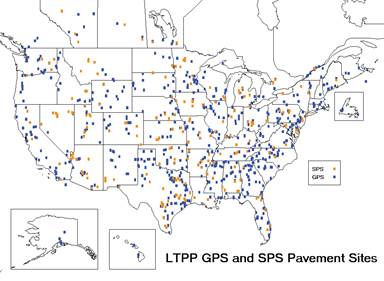 FIGURE 5.6. Locations of the 2,509 pavement test sections across the United States, Puerto Rico, and Canada: 791 in the General Pavement Studies (GPS) and 1,718 in the Specific Pavement Studies (SPS) over the course of the LTPP program. In 2014, 372 GPS and 360 SPS test sections were still being monitored. |
Establishing the LTPP experiments and selecting the appropriate test sections was not an easy task for those involved. However, the data that have been collected and the results obtained, as will be discussed later in this report, have been worth the effort. The careful planning, close collaboration among the LTPP program, highway agencies, industry, and contractor staff, and careful attention to the design details of the experiments have resulted in a sound research program that continues today. The following chapter covers the types of data collected at the LTPP test sections, the collection methods, and the equipment and instrumentation used since the beginning of the program.